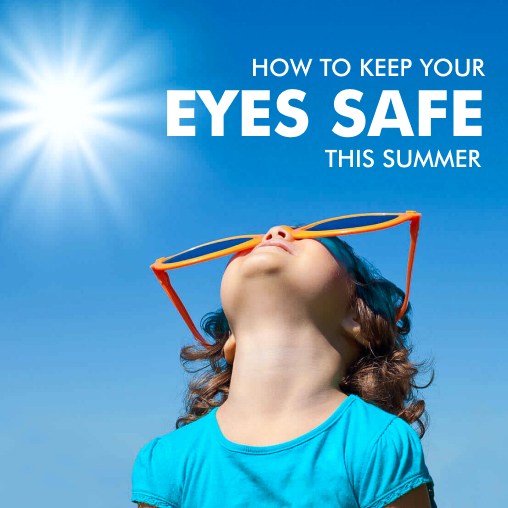Summer eye protection is important because the sun’s rays can be harmful to your eyes. Extended sun exposure leads people to develop different eye complications starting with cataracts continuing to macular degeneration and ending with eye irritations.
Eye tissues suffer damage from strong sun rays so it becomes vital to implement protective measures. Sunglasses equipped with UV protection can effectively lower the chances of eye damage when used for protection.
The summer season becomes accessible to people through basic protective measures which defend their eyesight. One must recognize both the threats to eye health and apply defensive actions to protect their eyes.
Key Takeaways
- Protect your eyes from UV radiation with sunglasses
- Avoid prolonged exposure to direct sunlight
- Wear protective eyewear during outdoor activities
- Be aware of the risks associated with summer sun exposure
- Take proactive steps to safeguard your vision
Summer Sun and Eye Health Risks
During summer with its prevalent warm and sunny conditions our eyes experience maximum danger to their health. Understanding the serious vision dangers UV radiation brings through sunlight calls for using protective measures since they protect our eyes from harm.
UV Radiation and Its Impact on Vision
UV radiation from the sun functions as a primary risk element for multiple disorders relating to eyesight. The continuous absorption of UV radiation may result in critical eye injuries that produce cataracts and lead to macular deterioration plus result in eye cancer development. UV radiation attacks our vision at any time since UV rays successfully pass through cloud cover.
Common Summer Eye Conditions
Several eye conditions become more common during summertime because of sun-bathed conditions and low moisture levels in the air.
- Photokeratitis (Sunburn of the Eye)
UV radiation causes photokeratitis which produces eye discomfort through its effects on individuals who remain outside without eye-protective equipment. The eyes show symptoms of redness along with pain that feels like there is grit in the eyes.
- Dry Eye Syndrome
Dry eye syndrome becomes worse when the period of hot dry conditions occurs during summer months. The condition produces unpleasant symptoms along with impaired vision and raises the chances of eye infections.
- Pterygium and Pinguecula
The eye surface develops pterygium and pinguecula growths which develop most frequently through excessive UV radiation exposure. Pterygium along with pinguecula appears on the surface and usually stay benign but may result in discomfort and vision interference.
- Long-term Effects of Sun Exposure
Multiple permanent negative effects affect eye health when people expose themselves to UV radiation from sunlight for extended periods.
- Cataracts and Macular Degeneration
Pronged sunshine exposure puts patients at major risk for two serious age-related vision problems cataracts and macular degeneration. Ignoring proper management will result in severe vision loss from these two conditions.
- Preventable Vision Loss
The use of sunglasses with UV protection and hats with wide brims helps prevent a large portion of sun-related vision loss which otherwise could happen to people exposed to UV radiation.
Essential Protection for Your Eyes During Summer
The more intense sunlight calls for critical defense of your sight. The primary cause of eye-related health concerns during summer stem from excessive UV radiation which people face outdoors. The administration of eye protection serves multiple purposes beyond comfort because it serves as your main defense against enduring eye injuries.
Quality Sunglasses: What to Look For
Both comfort and effectiveness heavily depend on selecting the right frame style and proper fit. You will obtain superior eye protection when your sunglasses properly stay on and encapsulate your eye area and nose area.
UV Protection Ratings Explained
Choosing sunglasses that provide eye protection depends heavily on understanding the meaning of UV ratings.
- UV400 vs. Category 3 and 4 Lenses
Sunglasses with UV400 protection block 99-100% of UVA and UVB rays. Category 3 and 4 lenses have equivalent protection capabilities under European standards.
- Polarized vs. Non-Polarized Options
Sunglasses that utilize polarized lenses successfully block reflective surface glare for improved visual contentment. The main advantage of these lenses lies in their enhanced visibility but they do not provide additional protection against UV rays.
Additional Protective Measures
Beyond sunglasses, other measures can enhance eye protection during summer.
- Hats and Visors
Protecting eyes from UV damage requires wearing either hats with wide brim shapes or visors that cover the face adequately.
- Proper Hydration and Nutrition
Both hydration and antioxidant and omega-3 fatty acids nutrients in your diet function together to create beneficial conditions for eye health.
Choosing the Right Sunglasses for Indian Summers
Indian summers are known for their intense sunlight, making the right sunglasses a necessity. The harsh sun can cause discomfort, eye strain, and even long-term damage to the eyes.
Dealing with Intense Tropical Sunlight
The tropical sunlight in India is particularly harsh due to its geographical location. Sunglasses with UV protection are essential to shield the eyes from harmful ultraviolet rays.
- Monsoon Season Considerations
Sunglasses need to contain strong UV protection measures since the monsoon sun brings intense sunlight even when it is not excessively hot. Water-resistant sunglasses function excellently during this time period.
- Dust and Pollution Protection
Dust along with pollution in Indian cities leads to eye irritation issues. People seeking eye protection should choose sunglasses that cover their field of vision completely or wear goggles because they block airborne dust along with pollutants from entering the eyes.
Protecting Your Eyes During Different Summer Activities
The necessity of vision protection becomes vital during all activities during this hot summer season. During summertime you need proper eye protection from the sun because these activities include beach visits and driving plus outdoor sports so the sun glare remains a serious threat to your eyes.
Beach and Water Activities
Visiting beaches during summer vacations usually requires water activities because these activities reflect harmful UV sunlight toward your eyes. You need to pick eye protection that is appropriate for the activities you plan to do.
- Waterproof Eyewear Options
Waterproof sunglasses become essential during aquatic activities since they offer both sun safety through UV blocking and attentive secure attachment.
- Post-Swimming Eye Care
Fresh water needs to be used for rinsing your eyes to eliminate chlorine or salt residue after swimming. Dr. Smith advises that post-swimming eye care helps prevent both infections and irritation in the eyes. Regular maintenance through cleaning procedures should be performed on your eyewear.
Outdoor Sports and Recreation
During summer people enjoy outdoor sports which include playing tennis alongside cricket and bicycle riding. Sports-oriented sun equipment functions to boost sports performance while safeguarding your eyes from harm.
- Sport-Specific Sunglasses
A variety of sporting activities demands particular varieties of protective eyewear. Sport-specific cycling sunglasses use a wrapping style to ensure full eyesight coverage whereas tennis players typically need light-weight frame designs for their sport.
- Impact-Resistant Features
People who play high-impact sports must use lenses that protect against impacts. Polycarbonate lenses serve as a widely chosen option because they deliver both durability along with a lightweight design.
Driving in Bright Sunlight
Driving during summer months becomes difficult because of the powerful sun rays. The selection of lens color plays an effective role in cutting down glare amounts.
- Best Lens Colors for Driving
Gray together with amber lenses provide optimal driving conditions because they eliminate glare without affecting color perception. An expert in eye care specifies that gray lenses work well in sunny conditions by reducing total brightness.
Children’s Eye Protection Needs
Eye exposure risks increase among children because their eyes remain in a developing state. It is essential to get children sunglasses that fit their age range.
- Age-Appropriate Sunglasses
Young children need sunglasses which both fit their faces properly and cover them from ultraviolet rays effectively. Children can choose from sunglasses with tough frames and adjustable elastic bands among other brands.
- Teaching Kids About Eye Safety
Proper education regarding protective eyewear for children helps develop lasting protective habits. A simple protection method including hat and sunglasses usage improves eye health effectively.
Conclusion
As the summer months approach, safeguarding your Eye Health becomes crucial. Prolonged exposure to the sun’s harsh rays can lead to various eye problems, making Summer Eye Care a top priority.
Throughout this article, we’ve discussed the risks associated with UV radiation and the importance of protective measures. Quality sunglasses with UV protection, hats, and sunglasses with polarized lenses can significantly reduce the risk of eye damage. It’s also essential to be mindful of eye protection during different summer activities, such as beach trips, outdoor sports, and driving.
By adopting these simple yet effective measures, you can enjoy the summer while maintaining your Eye Health. Prioritizing Summer Eye Care not only enhances your overall well-being but also ensures that your eyes remain healthy and protected throughout the season.
Make informed choices about your eye care, and take the necessary steps to safeguard your vision. With the right precautions, you can look forward to a fun-filled summer while keeping your eyes safe and healthy.
FAQ
1. What are the risks of not protecting my eyes during summer?
Not protecting your eyes during summer can lead to various eye conditions, including photokeratitis, dry eye syndrome, and increased risk of cataracts and macular degeneration due to prolonged exposure to UV radiation.
2. How do I choose the right sunglasses for summer?
To choose the right sunglasses, look for UV400 protection, consider polarized lenses to reduce glare, and opt for wrap-around frames or larger frames that provide more coverage. Brands like Ray-Ban and Oakley offer high-quality sunglasses with excellent UV protection.
3. Are polarized sunglasses better than non-polarized ones?
Polarized sunglasses are beneficial for reducing glare from reflective surfaces like water and roads, making them ideal for activities such as driving, fishing, or boating. However, they may not be necessary for everyone, and the choice depends on your specific needs and preferences.
4. Can I protect my eyes from the sun without wearing sunglasses?
While sunglasses are a crucial part of eye protection, you can also protect your eyes by wearing a hat or visor with a wide brim to shield your face and eyes from the sun, and by being mindful of the time you spend outdoors during peak sun hours.
5. How do I care for my eyes after swimming in a pool or ocean?
After swimming, rinse your eyes with clean water, and consider using artificial tears to moisturize your eyes if you experience dryness. It’s also a good idea to wear goggles or waterproof eyewear while swimming to protect your eyes from chlorine or saltwater.
6. What are some common eye conditions associated with summer?
Common summer eye conditions include photokeratitis (sunburn of the eye), dry eye syndrome, and pterygium (a growth on the conjunctiva or cornea). Prolonged UV exposure can also increase the risk of cataracts and macular degeneration.
7. How can I protect my children’s eyes during summer?
Protect your children’s eyes by ensuring they wear sunglasses with UV protection, hats, or visors when playing outside, teaching them about the importance of eye safety, and limiting their exposure to the sun during peak hours.


